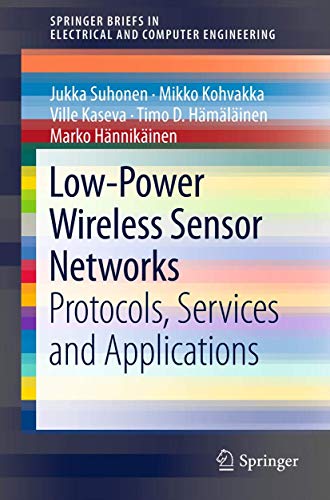Low-Power Wireless Sensor Networks: Protocols, Services and Applications (SpringerBriefs in Electrical and Computer Engineering) - Softcover
Buch 12 von 209: SpringerBriefs in Electrical and Computer Engineering
Inhaltsangabe
Wireless sensor network (WSN) is an ad-hoc network technology comprising even thousands of autonomic and self-organizing nodes that combine environmental sensing, data processing, and wireless networking. The applications for sensor networks range from home and industrial environments to military uses. Unlike the traditional computer networks, a WSN is application-oriented and deployed for a specific task. WSNs are data centric, which means that messages are not send to individual nodes but to geographical locations or regions based on the data content. A WSN node is typically battery powered and characterized by extremely small size and low cost.
As a result, the processing power, memory, and energy resources of an individual sensor node are limited. However, the feasibility of a WSN lies on the collaboration between the nodes. A reference WSN node comprises a Micro-Controller Unit (MCU) having few Million Instructions Per Second (MIPS) processing speed, tens of kilobytes program memory, few kilobytes data memory. In addition, the node contains a short-range radio, and a set of sensors. Supply power is typically obtained with small batteries. Assuming a target lifetime of one year using AA-size batteries, the available power budget is around 1 mW.
This book covers the low-power WSNs services ranging from hardware platforms and communication protocols to network deployment, and sensor data collection and actuation. The implications of resource constraints and expected performance in terms of throughput, reliability and latency are explained. As a case study, this book presents experiments with low-energy TUTWSN technology to illustrate the possibilities and limitations of WSN applications.
Die Inhaltsangabe kann sich auf eine andere Ausgabe dieses Titels beziehen.
Über die Autorin bzw. den Autor
none
„Über diesen Titel“ kann sich auf eine andere Ausgabe dieses Titels beziehen.
Suchergebnisse für Low-Power Wireless Sensor Networks: Protocols, Services...
Low-Power Wireless Sensor Networks: Protocols, Services and Applications (SpringerBriefs in Electrical and Computer Engineering)
Anbieter: Lucky's Textbooks, Dallas, TX, USA
Zustand: New. Bestandsnummer des Verkäufers ABLIING23Mar2716030035534
Neu kaufen
Versand innerhalb von USA
Anzahl: Mehr als 20 verfügbar
Low-Power Wireless Sensor Networks : Protocols, Services and Applications
Anbieter: GreatBookPrices, Columbia, MD, USA
Zustand: New. Bestandsnummer des Verkäufers 14212579-n
Neu kaufen
Versand innerhalb von USA
Anzahl: Mehr als 20 verfügbar
Low-Power Wireless Sensor Networks : Protocols, Services and Applications
Anbieter: GreatBookPrices, Columbia, MD, USA
Zustand: As New. Unread book in perfect condition. Bestandsnummer des Verkäufers 14212579
Gebraucht kaufen
Versand innerhalb von USA
Anzahl: Mehr als 20 verfügbar
Low-Power Wireless Sensor Networks : Protocols, Services and Applications
Anbieter: Chiron Media, Wallingford, Vereinigtes Königreich
PF. Zustand: New. Bestandsnummer des Verkäufers 6666-IUK-9781461421726
Neu kaufen
Versand von Vereinigtes Königreich nach USA
Anzahl: 10 verfügbar
Low-Power Wireless Sensor Networks
Anbieter: Books Puddle, New York, NY, USA
Zustand: New. pp. 100. Bestandsnummer des Verkäufers 2654504238
Neu kaufen
Versand innerhalb von USA
Anzahl: 4 verfügbar
Low-Power Wireless Sensor Networks : Protocols, Services and Applications
Anbieter: GreatBookPricesUK, Woodford Green, Vereinigtes Königreich
Zustand: New. Bestandsnummer des Verkäufers 14212579-n
Neu kaufen
Versand von Vereinigtes Königreich nach USA
Anzahl: Mehr als 20 verfügbar
Low-Power Wireless Sensor Networks
Print-on-DemandAnbieter: BuchWeltWeit Ludwig Meier e.K., Bergisch Gladbach, Deutschland
Taschenbuch. Zustand: Neu. This item is printed on demand - it takes 3-4 days longer - Neuware -Wireless sensor network (WSN) is an ad-hoc network technology comprising even thousands of autonomic and self-organizing nodes that combine environmental sensing, data processing, and wireless networking. The applications for sensor networks range from home and industrial environments to military uses. Unlike the traditional computer networks, a WSN is application-oriented and deployed for a specific task. WSNs are data centric, which means that messages are not send to individual nodes but to geographical locations or regions based on the data content. A WSN node is typically battery powered and characterized by extremely small size and low cost. As a result, the processing power, memory, and energy resources of an individual sensor node are limited. However, the feasibility of a WSN lies on the collaboration between the nodes. A reference WSN node comprises a Micro-Controller Unit (MCU) having few Million Instructions Per Second (MIPS) processing speed, tens of kilobytes program memory, few kilobytes data memory. In addition, the node contains a short-range radio, and a set of sensors. Supply power is typically obtained with small batteries. Assuming a target lifetime of one year using AA-size batteries, the available power budget is around 1 mW. This book covers the low-power WSNs services ranging from hardware platforms and communication protocols to network deployment, and sensor data collection and actuation. The implications of resource constraints and expected performance in terms of throughput, reliability and latency are explained. As a case study, this book presents experiments with low-energy TUTWSN technology to illustrate the possibilities and limitations of WSN applications. 100 pp. Englisch. Bestandsnummer des Verkäufers 9781461421726
Neu kaufen
Versand von Deutschland nach USA
Anzahl: 2 verfügbar
Low-Power Wireless Sensor Networks : Protocols, Services and Applications
Anbieter: GreatBookPricesUK, Woodford Green, Vereinigtes Königreich
Zustand: As New. Unread book in perfect condition. Bestandsnummer des Verkäufers 14212579
Gebraucht kaufen
Versand von Vereinigtes Königreich nach USA
Anzahl: Mehr als 20 verfügbar
Low-Power Wireless Sensor Networks
Print-on-DemandAnbieter: Majestic Books, Hounslow, Vereinigtes Königreich
Zustand: New. Print on Demand pp. 100 32 Illus. Bestandsnummer des Verkäufers 55055601
Neu kaufen
Versand von Vereinigtes Königreich nach USA
Anzahl: 4 verfügbar
Low-power Wireless Sensor Networks: Protocols, Services and Applications
Anbieter: Revaluation Books, Exeter, Vereinigtes Königreich
Paperback. Zustand: Brand New. 1st edition. 90 pages. 9.00x6.00x0.25 inches. In Stock. Bestandsnummer des Verkäufers x-1461421721
Neu kaufen
Versand von Vereinigtes Königreich nach USA
Anzahl: 2 verfügbar
